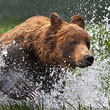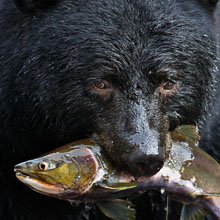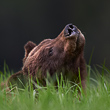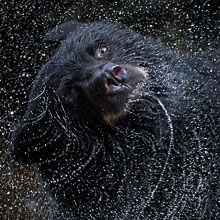Availability: Undetermined - Enquiries?
In the Field
ESCAPE! Khutzeymateen Grizzly Sanctuary, Great Bear Rainforest (northern BC coast). May 27, 2013.
We all know wildlife, including bears, aren't evenly distributed in space and time. There are many areas with no grizzlies, and some areas with lots of them. And, when you find an area with lots of them you get something else - lots of interesting interactions between the bears! This young male (who's maybe 6 or 7 years old) has just decided that discretion (and pretty extreme discretion at that!) is far better than valour and is doing he best to avoid interacting with another bear! About 5 minutes before I captured this shot this bear had been peacefully foraging on a rapidly shrinking (due to a rising tide) island of grass. Then he spotting another male about 250 meters (that's about 9852" - or 50 rods - for those who might not be comfortable with the metric system) away, but who was moving toward this bear pretty fast. Well...this guy was taking no chances...and he instantly put it in overdrive and just ripped through the shallow water on "his" island (which he was more than happy to surrender!).
Each year when I go into the Khutzeymateen I spend a bit of time before-hand reviewing the bear images I already have - mainly to look for "gaps" in my library of bear shots. This year I noticed I didn't have too many shots of running bears, and decided I really wanted to capture a shot of bear running directly at me, and preferably in water (for the splashing effect). Well...now that my Khutzeymateen trip for 2013 is in the past, I have to admit failure! Running bear? Yes. Running right at me? Nope - struck out on that (but why am I not too disappointed?). But there's always next year...
Now just "wanting" an image of a bear doing something special doesn't make it happen, even in the Khutzeymateen. But I did do a few things that helped improve the chances of capturing the running bear shot. First, I really watched for the opportunity. That sounds almost simplistic or silly, but in this specific situation what it meant was ignoring a female grizzly with two cubs that were "performing" at the other end (the front end) of the Zodiac - just so I could keep my eye on this guy (who we knew was a skittish bear and ran from most anything, probably including his own shadow). So...I gave up a lot of good shots of cute cubs interacting with their mom just because this bear MIGHT run. For me, giving up on the mom and cubs wasn't too easy to swallow at the time, but now I'm glad I did.
Second, I ensured my camera (my Nikon D4) was set up so that I could switch from one group of settings to a second group of settings (i..e, ones to ensure I could freeze action) in an eyeblink. This involves correctly setting up a few functions on the camera, including Auto ISO (with a very fast shutter speed, in this case a minimum of 1/1600s), then storing the Auto ISO and other preferred settings in a Shooting Bank. Finally, I had to "program" the Function button so I could toggle between Shooting Banks fast (without having to go into menus). Once all this is done it means that the user can toggle between their "normal" settings in on Shooting Bank (perhaps Auto ISO off or whatever they want) and their "action" settings just by pushing the function button and spinning the Command dial. Which, with just a little practice, becomes second nature and can be done really fast. In this case there's just no way on earth I would have captured this shot if I hadn't set up my camera this way...
A note to D7000, D7100, and D600 users: This is even easier for you to do - instead of setting up Shooting Banks to store your Auto ISO settings, you can store all the settings needed in your "User Settings" (and you can even go one step further and store Auto Focus preferences (such as the type of Dynamic Area settings you might want to store with your other "Action" settings). Still wishing Nikon would add the User Settings capability to their full "pro" cameras.
Oh...and a note to Canon users - sorry...but you can't set up YOUR cameras this way (almost, but not quite). Why? Simply because the shortest shutter speed you can "program" into your Auto ISO function is 1/250 second. For some inexplicable reason Canon hasn't made the full range of shutter speeds available in their Auto ISO function - on any camera. This might seem like a small thing, but for anyone wanting to freeze action over a wide range of conditions in a field setting (where you may want to go from shooting a flower to a running bear in seconds), it's a pretty important thing. And perhaps I shouldn't have pointed this out - I wonder how long before Canon "fixes" this in a firmware update? Hey...you'll be thanking me then! ;-)
Here's a higher resolution (2400 pixel) version of this blazing bruin for those wanting to see more detail:
• ESCAPE! Download 2400 pixel image (JPEG: 2.2 MB)
ADDITIONAL NOTES:
1. This image - in all resolutions - is protected by copyright. I'm fine with personal uses of them (including use as desktop backgrounds or screensavers on your own computer), but unauthorized commercial use of the image is prohibited by law. Thanks in advance for respecting my copyright!
2. This image was captured during one of my two spring "Grizzlies of the Khutzeymateen" photo tours in May/June of 2013. Each year I offer trips into two different parts of the Great Bear Rainforest as well as one to photograph aquatic mammals and oceanscapes near the northern tip of Vancouver Island. And, in selected years, I also offer photo tours to locations to capture other highly sought-after subjects, such as various boreal owl species and wildlife of Canada's Arctic. Details about these trips can be found on the Photo Tours page of this website.
3. Like all wildlife photographs on this website, this image was captured following the strict ethical guidelines described in The Wildlife FIRST! Principles of Photographer Conduct. I encourage all wildlife photographers to always put the welfare of their subjects above the value of their photographs.
Behind the Camera
ESCAPE! Khutzeymateen Grizzly Sanctuary, Great Bear Rainforest (northern BC coast). May 27, 2013.
Digital Capture; Compressed RAW (NEF) 14-bit format; ISO 500.
Nikon D4 paired with Nikkor 400mm f2.8 VRII - hand-held from floating Zodiac. VR on and in normal mode.
1/1600s @ f5.6; -0.67 stop compensation from matrix-metered exposure setting. Auto ISO engaged with minimum shutter speed set to 1/1600s.
At the Computer
ESCAPE! Khutzeymateen Grizzly Sanctuary, Great Bear Rainforest (northern BC coast). May 27, 2013.
RAW Conversion to 16-bit TIFF, including first-pass/capture sharpening using Capture One Pro version 7. Three raw variants (images processed from raw) differing by a total of 1.3 stops in total exposure.
Further digital corrections on resulting 16-bit TIFF files using Adobe's Photoshop CS6 and Light Craft's Lightzone. Photoshop adjustments included compositing/blending the exposure variants, colour tweaks (hue rotation and desaturation of selected colours), selective contrast adjustment (using selective curves adjustment) and selective exposure tweaks . Final tone tweaking - specifically on the splashing water and bear's head - performed using tonemapper/re-light tool in Lightzone.
Conservation
ESCAPE! Khutzeymateen Grizzly Sanctuary, Great Bear Rainforest (northern BC coast). May 27, 2013.
Ten percent of the revenue generated by this image will be donated to Raincoast*.
Species Status in Canada**: Special Concern (May 2002).
While Grizzly Bears (Ursus arctos) are not technically listed as "Endangered" in Canada, they have been extirpated from most of their historical range. Grizzly Bears are far more sensitive to intrusion/disturbance in their habitat than are Black Bears and are being increasingly forced into marginal habitat by human encroachment. The Great Bear Rainforest along the central and northern coast of British Columbia is one of the last strongholds of the Grizzly Bear in Canada, and even this population is coming under increasing pressure.
On December 18, 2017 the government of British Columbia banned grizzly hunting across the entire province. This major conservation victory came after decades of tireless work by many dedicated conservationists and ecologists and, most importantly, it reflects the opinion of the vast majority of British Columbians. And, it means that AT LEAST while the current government remains in power grizzlies are finally "safe" in British Columbia.
Now that we've at least temporarily won the battle to save grizzlies in BC, it's time to re-focus our efforts toward protecting ALL of BC's carnivores, including Gray Wolves, Black Bears, Cougars, Wolverines, and more! Simply put, there are no ecological, economic, or ethical arguments supporting the trophy hunting of carnivores.
In a great first step towards ending the hunting of carnivores throughout BC the Raincoast Conservation Foundation has developed a program designed to protect ALL carnivores within the Great Bear Rainforest. Details about this program can be found on this page on Raincoast's website. Check it out and, better yet, make a donation to help Raincoast purchase the remaining commercial hunting tenures in the Great Bear!
*The Raincoast Conservation Society (and Foundation) is an effective and efficient organization that has been fighting for protection of this unique habitat. If you are looking for a meaningful way to contribute to the conservation of this amazing ecosystem, Raincoast will provide maximal "bang" for your conservation dollars.
**as determined by COSEWIC: The Committee on the Status of Endangered Wildlife in Canada

























